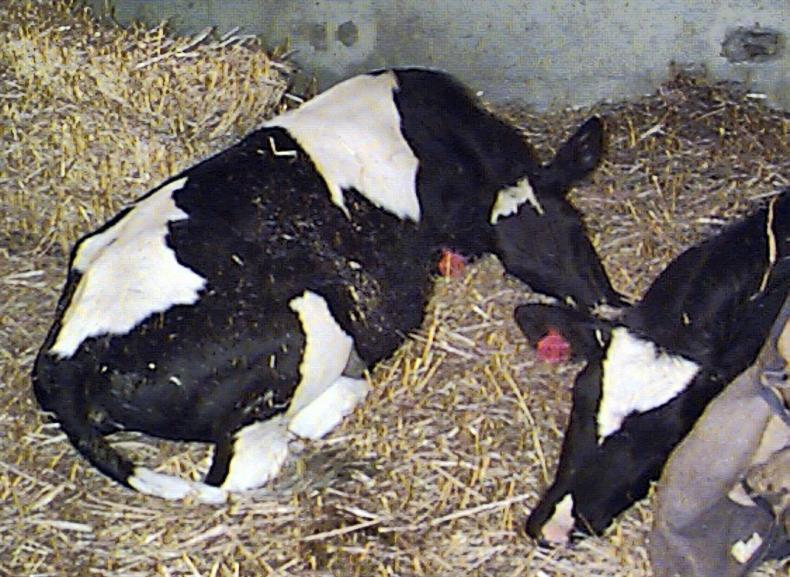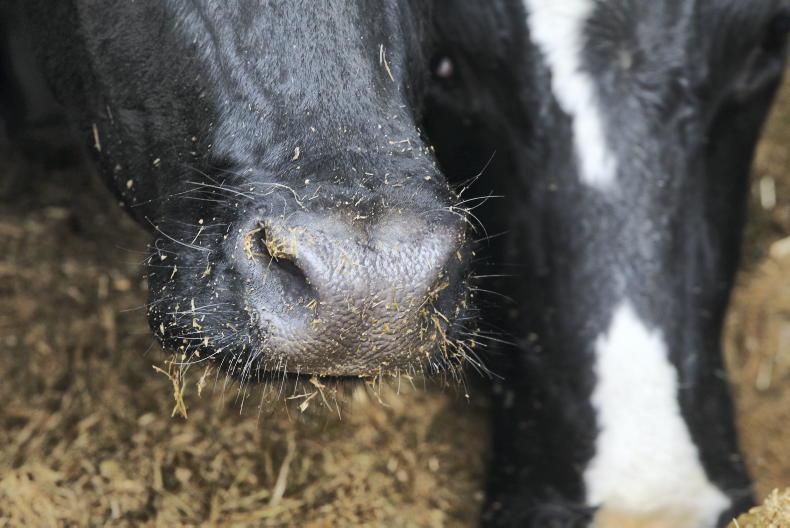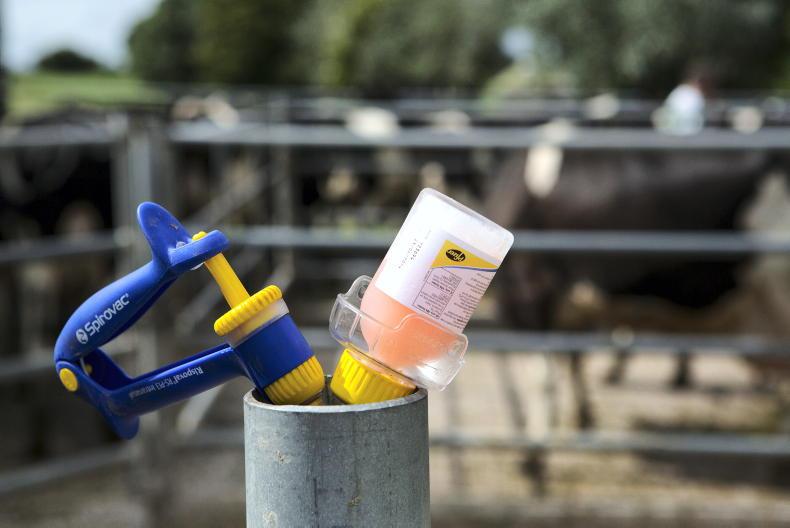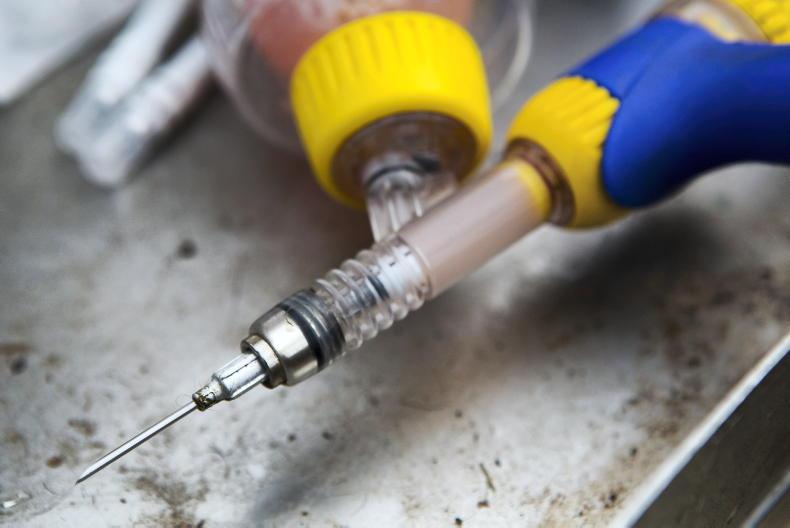In recent months, a number of suspect cases of botulism have been identified on various farms. The exact extent of this problem is difficult to determine since botulism is not a notifiable disease and in many sudden death cases in cattle it is difficult to prove botulism as the cause.
Botulism can affect cattle of all ages. It is caused by a bacterium called clostridium botulinum which produces a harmful toxin. There are five types of the botulism toxin: A, B, C, D and E. Types C and D are common to cattle.
Cattle can contract botulism by contact with contaminated decomposing organic material such as poultry litter which contains dead poultry carcases when spread on land grazed by cattle.
Other potential sources of contamination include exposure to other rotten animal carcases which may be caused by inappropriate disposal of foetal material or other fallen livestock.
Clinical signs
In the early stages of the disease, affected cattle may be seen to stagger and develop hind limb weakness. Often this is only evident when driving the animal since most are reluctant to move. They occasionally become aggressive and may attempt to rush at handlers.
Affected animals may be found lying on their chest with the head turned towards the flank (similar to cows with milk fever). As a colleague once appropriately described these cases, they often look as though they are “glued” to the ground. This is due to the paralysis of the limbs and the animal’s inability to control any muscles other than those of the main body.
Breathing eventually becomes difficult when the chest muscles become paralysed and most, if not all, affected animals either die or are euthanised by the attending veterinary surgeon.
It is important to remember that if high levels of the toxin are eaten by the animal, these symptoms will not be evident and the animal will be found dead with no previous clinical signs.
There is strong circumstantial evidence that poultry litter, as mentioned, is a major risk factor for botulism in Ireland today. Certainly vets in counties that have a large poultry production base would be more familiar with the disease than those in other counties.
The presence of the carcases of birds that have died during production is regarded as the most likely source of the toxin.
It is suggested that even small pieces of affected tissue, transferred on to the pasture by either direct application or by scavenger animals such as foxes or crows, can present a risk to grazing animals. With this in mind, it is important to consider not only correct spreading of litter but also correct storage (eg to limit access to scavenger animals).
Correct disposal of animal or bird carcases is the key to the prevention of this disease. Strict guidelines for both the disposal of fallen livestock and bird carcases are available from your local Department of Agriculture veterinary office.
Poultry carcases should be promptly removed from the chicken house and disposed of by incineration. The use of on-farm disposal by burial is not acceptable.
Poultry precautions
The following is a list of precautionary measures that can be taken by the poultry farmer:
Frequent inspection of the flock so as to identify and remove dead birds.Correct disposal of any bird tissue by incineration.When empty, the doors of the poultry house should be kept closed to prevent access by scavenging animalsAdequate pest control programme.Litter should not be removed until such times as it can be immediately transported in covered vehicles.Washings from the house should be collected in tanks rather than allowed to contaminate neighbouring soil and possible watercourses.Machinery (eg skid steer loaders) used in the handling of litter should be properly washed and disinfected before any further use, especially if used to handle animal feed.Spreading precautions
When spreading poultry litter a number of precautionary steps can be taken to limit the risk from botulism.
Some of these precautionary steps are outlined below:
Only accept and spread litter from poultry farms with appropriate litter management procedures in place. If under inspection, the litter contains any dead or rotting animal material, reject immediately.Spread on tillage land only if possible and reduce risk from scavenging animals by ploughing in immediately after application.If spread on pasture, avoid grazing for at least six weeks. Some researchers indicate that the toxin, if present in high amounts, can pose a threat for much longer.Avoid spreading or stockpiling litter during hot weather. The increase in temperature may further increase the production of the toxin within the litter.Avoid spreading during high winds and close to watercourses, as this can cause contamination to neighbouring land.Always report sudden or unexpected deaths in cattle to your local district veterinary office or private practitioner, especially if associated with recent access to poultry litter.Risk to humans
Although humans can be affected by botulism, the sources of the disease for cattle are not considered a great risk for humans. It is thought that humans are resistant to the strains of the toxin that affect cattle.
However, the Department of Agriculture and Food recommends that operators wear gloves, wash their hands immediately after handling dead animals/poultry litter, and generally avoid excessive contact with risk material.
This is a deadly disease of cattle with no possible treatment available in southern Ireland. The animal affected is either found dead or will die over a period of time from progressive paralysis. Conclusive diagnosis of this disease is often difficult and involves prolonged testing in the laboratory. Currently such facilities in Ireland are limited.
Although other sources of infection do occur the most common source of infection to cattle is direct or indirect exposure to poultry litter. The key, therefore, in controlling this potentially devastating disease is strict litter management and limiting exposure to cattle by correct management procedures during both storage and spreading of poultry litter.
Currently the challenge to the poultry industry is the development of alternative methods of disposal other than land spreading.
Read more
Cattle die in Kilkenny botulism outbreak
Suspected botulism outbreak in Meath
In recent months, a number of suspect cases of botulism have been identified on various farms. The exact extent of this problem is difficult to determine since botulism is not a notifiable disease and in many sudden death cases in cattle it is difficult to prove botulism as the cause.
Botulism can affect cattle of all ages. It is caused by a bacterium called clostridium botulinum which produces a harmful toxin. There are five types of the botulism toxin: A, B, C, D and E. Types C and D are common to cattle.
Cattle can contract botulism by contact with contaminated decomposing organic material such as poultry litter which contains dead poultry carcases when spread on land grazed by cattle.
Other potential sources of contamination include exposure to other rotten animal carcases which may be caused by inappropriate disposal of foetal material or other fallen livestock.
Clinical signs
In the early stages of the disease, affected cattle may be seen to stagger and develop hind limb weakness. Often this is only evident when driving the animal since most are reluctant to move. They occasionally become aggressive and may attempt to rush at handlers.
Affected animals may be found lying on their chest with the head turned towards the flank (similar to cows with milk fever). As a colleague once appropriately described these cases, they often look as though they are “glued” to the ground. This is due to the paralysis of the limbs and the animal’s inability to control any muscles other than those of the main body.
Breathing eventually becomes difficult when the chest muscles become paralysed and most, if not all, affected animals either die or are euthanised by the attending veterinary surgeon.
It is important to remember that if high levels of the toxin are eaten by the animal, these symptoms will not be evident and the animal will be found dead with no previous clinical signs.
There is strong circumstantial evidence that poultry litter, as mentioned, is a major risk factor for botulism in Ireland today. Certainly vets in counties that have a large poultry production base would be more familiar with the disease than those in other counties.
The presence of the carcases of birds that have died during production is regarded as the most likely source of the toxin.
It is suggested that even small pieces of affected tissue, transferred on to the pasture by either direct application or by scavenger animals such as foxes or crows, can present a risk to grazing animals. With this in mind, it is important to consider not only correct spreading of litter but also correct storage (eg to limit access to scavenger animals).
Correct disposal of animal or bird carcases is the key to the prevention of this disease. Strict guidelines for both the disposal of fallen livestock and bird carcases are available from your local Department of Agriculture veterinary office.
Poultry carcases should be promptly removed from the chicken house and disposed of by incineration. The use of on-farm disposal by burial is not acceptable.
Poultry precautions
The following is a list of precautionary measures that can be taken by the poultry farmer:
Frequent inspection of the flock so as to identify and remove dead birds.Correct disposal of any bird tissue by incineration.When empty, the doors of the poultry house should be kept closed to prevent access by scavenging animalsAdequate pest control programme.Litter should not be removed until such times as it can be immediately transported in covered vehicles.Washings from the house should be collected in tanks rather than allowed to contaminate neighbouring soil and possible watercourses.Machinery (eg skid steer loaders) used in the handling of litter should be properly washed and disinfected before any further use, especially if used to handle animal feed.Spreading precautions
When spreading poultry litter a number of precautionary steps can be taken to limit the risk from botulism.
Some of these precautionary steps are outlined below:
Only accept and spread litter from poultry farms with appropriate litter management procedures in place. If under inspection, the litter contains any dead or rotting animal material, reject immediately.Spread on tillage land only if possible and reduce risk from scavenging animals by ploughing in immediately after application.If spread on pasture, avoid grazing for at least six weeks. Some researchers indicate that the toxin, if present in high amounts, can pose a threat for much longer.Avoid spreading or stockpiling litter during hot weather. The increase in temperature may further increase the production of the toxin within the litter.Avoid spreading during high winds and close to watercourses, as this can cause contamination to neighbouring land.Always report sudden or unexpected deaths in cattle to your local district veterinary office or private practitioner, especially if associated with recent access to poultry litter.Risk to humans
Although humans can be affected by botulism, the sources of the disease for cattle are not considered a great risk for humans. It is thought that humans are resistant to the strains of the toxin that affect cattle.
However, the Department of Agriculture and Food recommends that operators wear gloves, wash their hands immediately after handling dead animals/poultry litter, and generally avoid excessive contact with risk material.
This is a deadly disease of cattle with no possible treatment available in southern Ireland. The animal affected is either found dead or will die over a period of time from progressive paralysis. Conclusive diagnosis of this disease is often difficult and involves prolonged testing in the laboratory. Currently such facilities in Ireland are limited.
Although other sources of infection do occur the most common source of infection to cattle is direct or indirect exposure to poultry litter. The key, therefore, in controlling this potentially devastating disease is strict litter management and limiting exposure to cattle by correct management procedures during both storage and spreading of poultry litter.
Currently the challenge to the poultry industry is the development of alternative methods of disposal other than land spreading.
Read more
Cattle die in Kilkenny botulism outbreak
Suspected botulism outbreak in Meath










SHARING OPTIONS